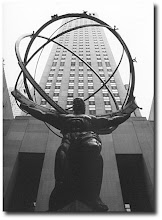In the Bank of Canada's statement today, they mentioned that they were open to quantitative easing. I'd heard this phrase used by the Federal Reserve in the fall, but I hadn't really understood what it means or how it is different from open market operations.
Turns out, they are quite similar. When a central bank announces a change to the target of their benchmark rate they must either buy or sell government securities in the open market. In order to lower (raise) interest rates, the bank must buy (sell) government bonds in the open market. These transactions change the size of the money supply causing the benchmark rate to approach its target.
Quantitative easing involves purchasing a wider variety of securities or accepting securities as collateral for loans from the central bank. Both buying and lending increase the amount of money in circulation.
Remember all those mortgage backed securities and collateralized debt obligations that the US banks couldn't wait to get off of their balance sheets? The Federal Reserve will accept the best of these assets as collateral for loans in order to infuse the economy with more money.
A slightly more technical, but still accessible explanation is available here.
3.3.09
Subscribe to:
Post Comments (Atom)

No comments:
Post a Comment